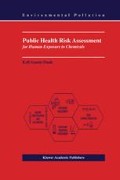Abstract
In the landmark book — Silent Spring — from the early 1960s, Rachel Carson wrote (Carson, 1962; 1994): ‘For the first time in the history of the world, every human being is now subjected to contact with dangerous chemicals, from the moment of conception until death.’ And this statement of some more than four decades ago is not about to change, given our dependency — maybe even obsession — with a ‘modern way of life.’ Indeed, in everyday living, peoples around the world — directly or indirectly — are exposed to myriad sources and cocktails of chemical hazards. Ultimately, chemical exposure problems may pose significant risks to the general public because of the potential health effects. Risks to human health as a result of exposure to toxic materials present or introduced into our living and work environments are, therefore, a matter of grave concern to modern society. To borrow again from Rachel Carson’s Silent Spring, ‘if we are going to live so intimately with these chemicals — eating and drinking them, taking them into the very marrow of our bones’, then at the very least, we should be able to determine the risks that we are exposed to, as well as know how to manage such risks — in order to ensure a quality to our life (Carson, 1962; 1994).
Access this chapter
Tax calculation will be finalised at checkout
Purchases are for personal use only
Preview
Unable to display preview. Download preview PDF.
Suggested Further Reading
American Academy of Pediatrics, 1993. Lead poisoning: from screening to primary prevention, Pediatrics, 92(1): 176–183
American Academy of Pediatrics, 1995. Treatment guidelines for lead exposure in children, Pediatrics, 96(1): 155–160
Barry, PSI, 1975. A comparison of concentrations of lead in human tissue, British Journal of Industrial Medicine, 32: 119–139
Barry, PSI, 1981. Concentrations of lead in the tissues of children, British Journal of Industrial Medicine, 38: 61–71
Bates, DV, 1994. Environmental Health Risks and Public Policy, University of Washington Press, Seattle, Washington
British Medical Association, 1998. Health & Environmental Impact Assessment (An Integrated Approach), British Medical Association (BMA), England, UK
Christen, K., 2001. The arsenic threat worsens, Environmental Science & Technology, 35(13):286A–291A
Francis, BM, 1994. Toxic Substances in the Environment, J. Wiley, New York
Freeze, RA, 2000. The Environmental Pendulum, University of California Press, Berkeley, CA
Gilliland, FD, KT Berhane, et al., 2002. Dietary magnesium, potassium, sodium, and children’s lung function, American Journal of Epidemiology, 155(2): 125–131
Mitchell, P. and D. Barr, 1995. The nature and significance of public exposure to arsenic: a review of its relevance to South West England, Environmental Geochemistry and Health, 17: 57–82
Pocock, SJ, M. Smith, and P. Baghurst, 1994. Environmental lead and children’s intelligence: a systematic review of the epidemiological evidence, British Medical Journal, 309: 1189–97
USEPA, 2001. Providing Solutions for a Better Tomorrow — reducing the risks associated with lead in soil, EPA/600/F-01/014, Office of Research and Development, US Environmental Protection Agency (USEPA), Washington, DC
Author information
Authors and Affiliations
Rights and permissions
Copyright information
© 2002 Springer Science+Business Media New York
About this chapter
Cite this chapter
Asante-Duah, K. (2002). Introduction. In: Public Health Risk Assessment for Human Exposure to Chemicals. Environmental Pollution, vol 6. Springer, Dordrecht. https://doi.org/10.1007/978-94-010-0481-7_1
Download citation
DOI: https://doi.org/10.1007/978-94-010-0481-7_1
Publisher Name: Springer, Dordrecht
Print ISBN: 978-1-4020-0921-1
Online ISBN: 978-94-010-0481-7
eBook Packages: Springer Book Archive

